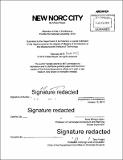New norc city/
Author(s)
Reyes, Ulises
DownloadFull printable version (19.90Mb)
Other Contributors
Massachusetts Institute of Technology. Department of Architecture.
Advisor
Anne Whiston Spirn.
Terms of use
Metadata
Show full item recordAbstract
People in cities in select parts of the world are on the cusp of a paradigm never before experienced by previous generations. The demographic-economic paradox tells us there is an inverse correlation found between wealth and fertility within nations. In other words, the higher the degree of education and GDP per capita of a human population, the fewer children born in any industrialized country. This phenomenon can be seen in Europe, where a decrease in fertility and mortality rates have resulted in people of ages 65 and older to comprise at least 15% of the population in over half of its countries with the potential of it rising to 35% in 2050. The aging of Japan is thought to outweigh all other nations, as the country is purported to have the highest proportion of elderly citizens, with almost one in four over the age of 65. Interesting phenomena have resulted from this situation, such as the sales of adult diapers outpacing the sales of infant diapers, and, as of 2005, its death rate outpacing its birth rate. While many living options are available to elderly populations, many of them are becoming financially out of reach for new generations of seniors. Popular in Europe, co-housing opens up new alternatives for seniors to, to live as independently as possible, as long as possible. Co-housing sets seniors up for success and helps them achieve their full potential in the last 20-30 years of life. Co-housing living arrangements support individual's well-being physically, socially, and emotionally, and offers aging adults a way to live among people with whom they share a common bond of age and experience-an entirely new way to house themselves with dignity, independence, safety, mutual concern, and fun. Looking at various neighborhoods in Boston as potential zones of concentration of elderly populations, this thesis aims to develop a new, scalable, co-housing typology that can be applied to cities with similar challenges.
Description
Thesis: M. Arch., Massachusetts Institute of Technology, Department of Architecture, 2015. Cataloged from PDF version of thesis. Includes bibliographical references (page 85).
Date issued
2015Department
Massachusetts Institute of Technology. Department of ArchitecturePublisher
Massachusetts Institute of Technology
Keywords
Architecture.